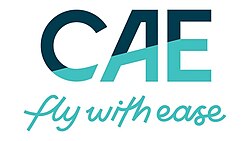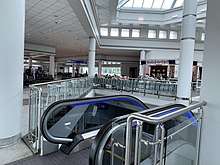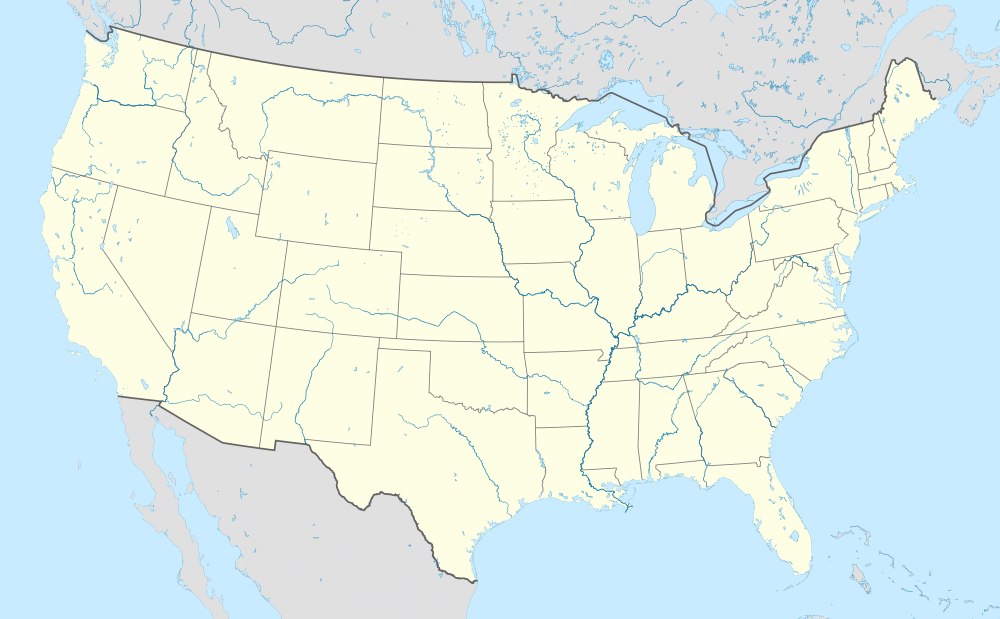Columbia Metropolitan Airport
Columbia Metropolitan Airport | |||||||||||||||
|---|---|---|---|---|---|---|---|---|---|---|---|---|---|---|---|
 | |||||||||||||||
 | |||||||||||||||
| Summary | |||||||||||||||
| Airport type | Public | ||||||||||||||
| Owner/Operator | Richland-Lexington Airport District | ||||||||||||||
| Serves | Columbia, South Carolina, U.S. | ||||||||||||||
| Location | West Columbia, South Carolina, U.S. | ||||||||||||||
| Hub for | UPS Airlines | ||||||||||||||
| Elevation AMSL | 236 ft / 72 m | ||||||||||||||
| Coordinates | 33°56′20″N 081°07′10″W / 33.93889°N 81.11944°W | ||||||||||||||
| Website | flycae | ||||||||||||||
| Map | |||||||||||||||
 | |||||||||||||||
| Runways | |||||||||||||||
| |||||||||||||||
| Helipads | |||||||||||||||
| |||||||||||||||
| Statistics (2023) | |||||||||||||||
| |||||||||||||||
Columbia Metropolitan Airport (IATA: CAE, ICAO: KCAE, FAA LID: CAE) is the main commercial airport for Columbia and the Midlands region of South Carolina, United States. The airport is located in West Columbia, five miles (8.0 km) southwest of Columbia, in Lexington County.[1] It is surrounded by the city of Cayce and the towns of Springdale, Pine Ridge, and South Congaree. The airport is a regional cargo hub for UPS Airlines.
History
[edit]World War II era
[edit]The airport was built in 1940 as Lexington County Airport. In 1940 the United States Army Air Corps indicated a need for the airfield as part of the buildup of its forces after World War II began in Europe. The earliest recorded Air Corps use of the airport was when the 105th Observation Squadron began flying Douglas O-38 and North American O-47 light observation aircraft on 24 September.[year needed]
In 1941 the airport came under formal military control, and an immediate program began to turn the civil airport into a military airfield. On 8 December 1941, as the Columbia Army Air Base, Columbia Army Airfield's mission was a training base for B-25 Mitchell crews.
One of the earliest units to train at Columbia AAB was the 17th Bombardment Group, which arrived on 9 February 1942. When the group arrived in Columbia its combat crews were offered the opportunity to volunteer for an "extremely hazardous" but unspecified mission which ultimately turned out to be the famous Doolittle Raid on Japan. Contrary to popular belief, the volunteers who made up the crews of the Doolittle Raid did not train for the Raid itself at Columbia.
Training at Columbia Army Air Base was phased down during the summer of 1945. Several units arrived at the base from overseas to inactivate during September and October. It was inactivated by the U.S. Army Air Forces on 30 November and returned to civil authorities, which converted it back to an airport. The 350th Bombardment Squadron was assigned to Columbia Metropolitan Airport on 16 July 1947 as part of the Air Force Reserve, but it was never equipped or manned; it was inactivated on 27 June 1949.
Postwar use
[edit]


Before World War II, Columbia's main civil airport had been Owens Field. However, its location near downtown made expansion impossible. Accordingly, in 1947, most frontline passenger service relocated to Lexington County Airport, which was renamed Columbia Metropolitan Airport. The city of Columbia built a new terminal at the airport in the early 1950s. It burned down, and a new one was built in its place.
In 1962, the Richland-Lexington Airport District was established to operate the airport. It is governed by a 12-member commission–five nominated by Lexington County's legislative delegation, five nominated by Richland County's legislative delegation, and two nominated by the Columbia city council.
Passenger service began on Delta Air Lines which has served Columbia for over 70 years. Delta began flights from Columbia to Charleston, Asheville, Jacksonville, Augusta, Savannah and New York–La Guardia. Delta DC-9 jet flights began March 7, 1966, with Flight 521 from Charleston continuing to Atlanta.
Eastern Airlines flew to Charlotte, Washington, and New York; it first scheduled jets to CAE in 1965. Piedmont Airlines flew from Augusta, Florence, and Charlotte in 1962. Southern Airways flew to Charleston and Greenville/Spartanburg. In January 1978 Eastern started flights to Atlanta after a route swap with Piedmont Airlines. Southern Airways left in December 1978, six months before their merger with North Central Airlines to form Republic Airlines. Atlantis Airlines started service in 1979 for a brief time using Twin Otter aircraft. Piedmont Airlines introduced nonstop service to Miami in January 1980, but dropped Columbia in June 1980 leaving only Delta and Eastern for a time.
In November 1982 Piedmont Airlines returned to Columbia with flights to Charlotte and later Newark. American Airlines would start service in 1985 to Raleigh and United Airlines would fly to Charlotte and Chicago–O'Hare. PeopleExpress and Continental Airlines. Freedom Airlines operated Convairs to Columbia in 1983. United Express (operated by Atlantic Coast Airlines) entered the market May 24, 1999 with service to Washington–Dulles and added Chicago–O'Hare on July 1, 2000. Northwest Airlines (operated by Pinnacle Airlines) came to Columbia on October 6, 2003, offering service to Detroit. On October 30, 2005, American Eagle returned after a nine-year absence with service to Dallas/Fort Worth after Delta closed their DFW hub earlier that year. In October 2010 US Airways Express operated by Air Wisconsin began non-stops to New York–La Guardia, but wound up discontinuing it as a result of a New York–La Guardia slot swap with Delta, which now has two daily flights to the airport.
Since 2000 the airport has tried to recruit low-cost carriers, but has been unable to maintain those services. Allegiant Air tried service to Orlando/Sanford, St. Petersburg/Clearwater and Fort Lauderdale in Florida, yet these services did not last. Independence Air served Columbia briefly in 2004 and 2005 with service to Washington–Dulles before ceasing its operations in January 2006. In May 2008, Spirit Airlines began service to Fort Lauderdale but terminated the route in March 2009. In 2011 Vision Airlines launched service to Destin, Florida, ending the route after a month.
In 2015 United Airlines CEO Jeff Smisek was forced to step down after it was revealed that he had continued to run an unprofitable route to the airport from Newark Liberty International Airport for former Port Authority of New York and New Jersey chairman David Samson.[3]
On June 7, 2018 American Airlines restored mainline service to Columbia with two daily nonstop flights to Dallas/Fort Worth.[4] The airline also announced it would start flights to/from Miami by the end of 2019.
Facilities
[edit]The airport covers 2,600 acres (1,100 ha) and has two runways: 11/29 is 8,601 ft × 150 ft (2,622 m × 46 m) and 5/23 is 8,001 ft × 150 ft (2,439 m × 46 m). It has a 50 ft × 50 ft (15 m × 15 m) helipad. The center 75 ft (23 m) of runway 5/23 is asphalt; the edges are grooved concrete.[1][5]
The airport is a hub for UPS Airlines and was a hub for Air South, a former low-cost carrier.
For the year ending February 22, 2022 the airport had 63,338 aircraft operations, an average of 174 per day: 46% general aviation, 23% air taxi, 23% airline and 8% military. In November 2023, there were 81 aircraft based at this airport: 44 single-engine, 13 multi-engine, 14 jet, 5 helicopter and 5 gliders.[1]
The terminal opened May 30, 1965, and was renovated in 1997. The renovation was designed by Heyward, Woodrum, Fant & Associates, Ltd.[6] It replaces a terminal built in the early 1950s which was a replacement of a terminal built several years earlier in the early 1950s.[7] Since the late 1980s, capital improvements have been undertaken, including a renovated and expanded terminal, a new parking garage (completed in 2003), the lengthening of the runways, and better interstate access. The terminal has several services, including gift shops, the Everett Adams Memorial Chapel, restaurants and bars inside the terminal. Free wireless internet service is provided throughout the airport as well as small number of recharge stations with access to outlets.
Police and fire/rescue services are provided by the Columbia Metro Airport Department of Public Safety. Public safety officers are South Carolina Police Academy Class 1 officers, and South Carolina Fire Academy IFSAC Firefighter II, and Airport Firefighter. Some have basic EMT certifications. The Department has three ARFF units, one RIV unit, one fire pumper, and a service truck. Law enforcement is covered by four patrol vehicles. The Department provides fire services at the FAR 139 level only. Structural firefighting is handled by Lexington County Fire Service.
Airlines and destinations
[edit]Passenger service is currently provided by five scheduled airlines, with commercial cargo service being handled by three scheduled airlines and numerous air freight operators. Two fixed-base operators also serve the Metro facility with various charter flights. The airport maintains a newly dedicated air cargo terminal, the Columbia Airport Enterprise Park (CAE Park) and Foreign Trade Zone #127. Columbia Metropolitan Airport recently completed a $45 million terminal expansion and renovation. Annually, the airport serves about 1 million passengers, though prior to the Great Recession, nearly 1.5 million passengers were served.[8]
Passenger
[edit]| Airlines | Destinations |
|---|---|
| Allegiant Air | Fort Lauderdale (begins May 22, 2025),[9] Orlando-Sanford (begins May 15, 2025)[10] |
| American Airlines | Dallas/Fort Worth |
| American Eagle | Charlotte, Chicago–O'Hare,[11] New York–LaGuardia, Philadelphia, Washington–National Seasonal: Miami |
| Delta Air Lines | Atlanta |
| Delta Connection | Atlanta, New York–LaGuardia |
| United Express | Chicago–O'Hare, Washington–Dulles |
| Destinations map |
|---|
Cargo
[edit]Statistics
[edit]Top destinations
[edit]| Rank | City | Passengers | Carriers |
|---|---|---|---|
| 1 | 191,000 | Delta | |
| 2 | 114,020 | American | |
| 3 | 65,000 | American | |
| 4 | 46,000 | American | |
| 5 | 28,000 | United | |
| 6 | 25,000 | United | |
| 7 | 21,000 | American | |
| 8 | 15,000 | Delta | |
| 9 | 6,000 | American |
Airline market share
[edit]| Rank | Airline | Passengers | Share |
|---|---|---|---|
| 1 | Delta Air Lines | 346,000 | 33.62% |
| 2 | PSA Airlines | 232,000 | 22.56% |
| 3 | Piedmont Airlines | 103,000 | 10.03% |
| 4 | Air Wisconsin | 102,000 | 9.88% |
| 5 | Envoy Air | 81,840 | 7.96% |
| Other | 164,000 | 15.95% |
Graphs are unavailable due to technical issues. There is more info on Phabricator and on MediaWiki.org. |
Annual traffic
[edit]| Year | Passengers | Year | Passengers | Year | Passengers |
|---|---|---|---|---|---|
| 2004 | 1,247,862 | 2014 | 1,034,133 | 2024 | |
| 2005 | 1,462,933 | 2015 | 1,102,011 | 2025 | |
| 2006 | 1,289,667 | 2016 | 1,132,329 | 2026 | |
| 2007 | 1,234,547 | 2017 | 1,077,188 | 2027 | |
| 2008 | 1,149,682 | 2018 | 1,197,603 | 2028 | |
| 2009 | 1,051,348 | 2019 | 1,353,788 | 2029 | |
| 2010 | 1,003,375 | 2020 | 577,187 | 2030 | |
| 2011 | 996,158 | 2021 | 870,806 | 2031 | |
| 2012 | 1,014,749 | 2022 | 1,063,630 | 2032 | |
| 2013 | 1,018,226 | 2023 | 1,234,487 | 2033 |
Southeastern regional cargo hub
[edit]In August 1996, the UPS Airlines-owned cargo airline opened an $80 million southeastern regional hub at the airport, one of six regional hubs throughout the United States. The hub offers next-day, second-day and third-day air service. The buildings encompass 352,000 square feet (32,700 m2) and the 44-acre (180,000 m2) ramp is large enough to hold 22 DC-8 aircraft. The hub can process 42,000 packages an hour. Other major air cargo companies serving the airport include ABX Air and FedEx Express.
Accidents and incidents
[edit]- A Volpar 18 (registration N47A[15]) crashed on February 26, 1971 while attempting to land at the airport. The aircraft crashed in poor visibility and fog while performing a missed approach, killing the pilot and seven passengers.[16]
- A Beechcraft C90 King Air (N711FC[17]) crashed on December 20, 1973 while attempting to land at the airport. The aircraft collided with trees after descending below minimum descent altitude in poor visibility. The pilot and a passenger were killed and another passenger was seriously injured.[18]
- A Learjet 60 (N999LJ[19]) crashed on September 19, 2008 while attempting a rejected takeoff on runway 11, crashing instead into the hillside across a road beyond the end of the runway. Four people died in the accident, including the two pilots. The sole survivors were musicians Travis Barker of Blink 182 and DJ Adam Goldstein, who died a year later.[20]
- On December 20, 2020, a Western Global Airlines Boeing 747 lost a wingtip on its right wing while taxiing before take-off at Columbia Metropolitan Airport, for a flight to Ontario International Airport in Ontario, California. No one aboard was reported injured.[21]
Features
[edit]- The airport's two airplane runways measure 8,000 feet (2,400 m) and 8,600 feet (2,600 m) in length.
- The airport runways can accommodate an airplane of any size, including the Boeing 747 and the military C-5A.
- The airport contains its own police department, fire station, and post office (Air Mail Facility).
- Decorative and semi-natural ponds bordering the sides of the airport terminal can be used by the airport fire department to put out fires.
- The air traffic control tower is 105 feet (32 m) tall.
- More than 1.1 million passengers travel through Columbia Metropolitan Airport each year.
- More than 1,400 people work at the airport.
In popular culture
[edit]- An opening scene in the 2006 film Borat: Cultural Learnings of America for Make Benefit Glorious Nation of Kazakhstan, starring Sacha Baron Cohen, was shot in the Columbia Metropolitan Airport terminal although it is labeled as "New York Airport."
- Air scenes from the 1943 World War II film A Guy Named Joe, starring Spencer Tracy and Lionel Barrymore, and directed by Victor Fleming, were filmed at what was then called the Columbia Army Air Base.
See also
[edit]References
[edit]- ^ a b c d FAA Airport Form 5010 for CAE PDF, effective January 25, 2024.
- ^ "CAE Airport Data for 2023". flycae.com. Retrieved February 12, 2024.
- ^ Harwell, Drew; Zezima, Katie (8 September 2015). "United Airlines chief steps down amid federal investigation" – via www.washingtonpost.com.
- ^ "Columbia Metropolitan Airport (CAE)". www.facebook.com. Retrieved 2018-07-03.
- ^ "CAE airport data at skyvector.com". skyvector.com. Retrieved September 16, 2022.
- ^ Natural light pours into the Columbia Metropolitan Airport Archived 2005-09-03 at the Wayback Machine
- ^ http://www.columbiaairport.com/ airport section, history subsection
- ^ http://www.thestate.com/2014/01/17/3213731/columbia-airport-traffic-increased.html Archived 2014-02-21 at the Wayback Machine Columbia airport traffic increased in 2013
- ^ https://www.abccolumbia.com/2024/11/19/columbia-metropolitan-airport-adds-allegiant-flights/
- ^ https://www.abccolumbia.com/2024/11/19/columbia-metropolitan-airport-adds-allegiant-flights/
- ^ "American Airlines announces new nonstop service from Columbia to Chicago". 20 February 2023. Retrieved June 3, 2024.
- ^ "Columbia, SC: Columbia Metropolitan (CAE)". June 2022. Retrieved October 2, 2022.
- ^ "Columbia, SC: Columbia Metropolitan (CAE)". June 2022. Retrieved June 17, 2023.
- ^ "CAE Airport Annual Activity Data 2004-Present". flycae.com. Retrieved June 25, 2024.
- ^ "FAA Registry (N47A)". Federal Aviation Administration.
- ^ National Transportation Safety Board. MIA71AM076
- ^ "FAA Registry (N711FC)". Federal Aviation Administration.
- ^ National Transportation Safety Board. MIA74AM049.
- ^ "FAA Registry (N999LJ)". Federal Aviation Administration.
- ^ "Crew in crash died of burns, smoke inhalation". 22 September 2008. Archived from the original on 2 December 2014. Retrieved 18 November 2019.
- ^ "Western Global Boeing 747-400 Loses Wingtip at Columbia". 20 December 2020.
External links
[edit]- Columbia Metropolitan Airport, official site
- FAA Airport Diagram (PDF), effective October 31, 2024
- FAA Terminal Procedures for CAE, effective October 31, 2024
- Resources for this airport:
- AirNav airport information for KCAE
- ASN accident history for CAE
- FlightAware airport information and live flight tracker
- NOAA/NWS weather observations: current, past three days
- SkyVector aeronautical chart for KCAE
- FAA current CAE delay information

